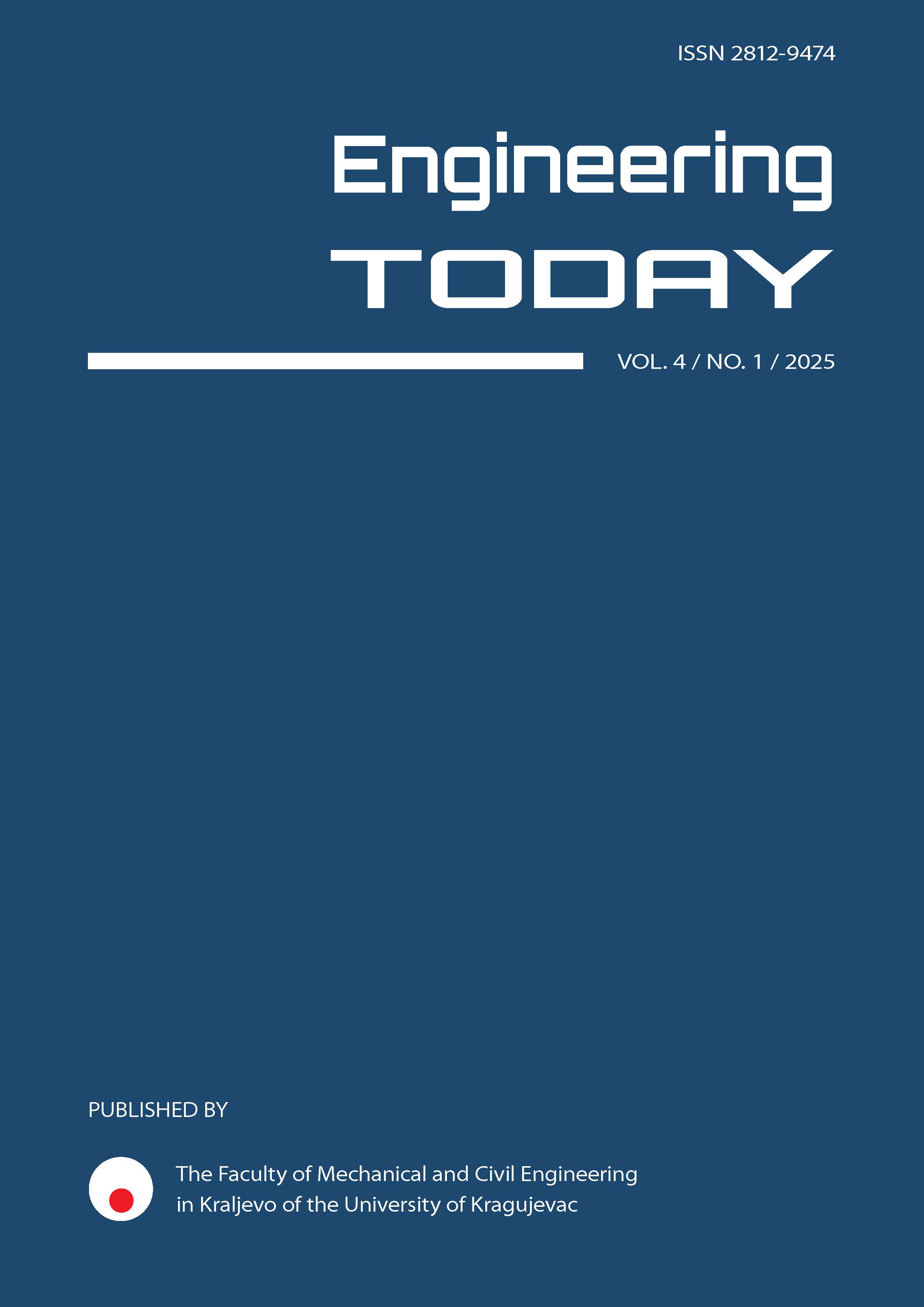Overview of the application of Artificial Neural Networks in the determination of some mechanical characteristics of masonry walls
Main Article Content
Abstract
Artificial intelligence (AI) has found wide application in solving many problems in engineering and also in construction, where its application is primarily reflected in faster and simpler solving of calculation problems. Artificial Neural Networks (ANN), as a method of artificial intelligence, are applied in the problems of construction design, management when making decisions, data analysis, design, optimization and prediction of construction responses. In the design phase of masonry structures, one of the main tasks is to adequately define the mechanical characteristics of the wall as a basis for quality design. The aim of this paper is to present and analyze the scientific results of the application of ANN in the determination of some of the mechanical characteristics of the walls in masonry constructions.
Article Details
References
[1] K. S. Alotaibi and K. Galal, “Application of artificial neural network in predicting compression strength of clay brick masonry prism”, 14th Canadian masonry symposium, Montreal (Canada), 16 May – 20May (2021)
[2] S. Carozza and M. Cimmino, “Artificial neural network implementation for masonry compressive strength estimation”, Structures and Buildings, Vol. 173(9), pp. 635-645, https://doi.org/10.1680/jstbu.18.00089, (2020)
[3] S. Biruntha, S. Dinesh, S. K. Ganesh, and V. Priyadharsini, “Artificial neural networks and their appliance to civil engineering – A review”, International Journal of Pure and Applied Mathematics, Vol. 119(12), pp. 717-725, (2018)
[4] D. S. Jeng, D. H. Cha and M. Blumenstein, “Application of neural network in civil engineering problems”, Technical Report, School of Engineering (Griffith University), Gold Coast (Australia), (2003)
[5] A. Doroshenko, “Applying artificial neural networks in construction“, 2nd International Symposium on Architecture Research Frontiers and Ecological Environment (ARFEE 2019), Vol. 143, https://doi.org/10.1051/e3sconf/202014301029, (2020)
[6] T. Gupta and R. K. Sharma, “Structural analysis and design of buildings using neural network: A review”, International Journal of Engineering and Management Sciences, Vol 2(4), pp. 216-220, (2011)
[7] P. Lu, S. Chen, and Y. Zheng, “Artificial Intelligence in Civil Engineering”, Mathematical Problems in Engineering, Vol. 2012, pp. 1-22 pages, https://doi.org/10.1155/2012/145974, (2012)
[8] H. Adeli, “Neural Networks in Civil Engineering: 1989−2000”, Computer-Aided Civil and Infrastructure Engineering, Vol. 16, pp. 126–142, https://doi.org/10.1111/0885-9507.00219, (2001)
[9] M. Lefik, “Some aspects of application of artificial neural network for numerical modeling in civil engineering”, Bulletin of the Polish Academy of Sciences: Technical Sciences, Vol. 61(1), pp. 39-50, https://doi.org/10.2478/bpasts-2013-0003, (2013)
[10] A. P. Ihom and A. Offiong, “Neural networks in materials science and engineering: A review of salient issues“, European Journal of Engineering and Technology, Vol. 3(7), pp. 40 – 54, (2015)
[11] M. Lazarevska, M. Knezevic, M. Cvetkovska, and A. Trombeva-Gavriloska, “Application of artificial neural networks in civil engineering” Tehnički vjesnik, Vol. 21(6), pp. 1353-1359, (2014)
[12] P. G. Asteris, I. Argyropoulos, L. Cavaleri, H. Rodrigues, H. Varum, J. Thomas, and P. B. Lourenço, “Masonry compressive strength prediction using artificial neural networks”, Transdisciplinary Multispectral Modeling and Cooperation for the Preservation of Cultural Heritage, First International Conference TMM_CH 2018, Athens (Greece), pp. 200-224, https://doi.org/10.1007/978-3-030-12960-6_14, (2018)
[13] H. Friaa, M. L. Hellara, I. Stefanou, K. Sab and A. Dogui, “Artificial neural networks prediction of in-plane and out-of-plane homogenized coefficients of hollow blocks masonry wall”, Meccanica, Vol. 55, pp. 525–545, https://doi.org/10.1007/s11012-020-01134-0, (2020)
[14] O. Onat and B. Yön, “Prediction and verification of compressive strength of historical masonry structures with artificial neural network” Journal of Structural Engineering & Applied Mechanics, Vol. 1(4), pp. 194-198, https://doi.org/10.31462/jseam.2019.01194198, (2019)
[15] S. R. Muthukumar and Jegatheeswaran, “Prediction of autoclaved aerated cement block masonry prism strength under compression using machine learning tools”, Revista Matéria, Vol. 29(1), https://doi.org/10.1590/1517-7076-RMAT-2023-0247, (2024)
[16] V. Plevris and P. G. Asteris, “Modeling of masonry failure surface under biaxial compressive stress using neural networks“, Construction and Building Materials, Vol. 55, pp. 447–461, https://doi.org/10.1016/j.conbuildmat.2014.01.041, (2014)
[17] P. G. Asteris and V. Plevris, “Anisotropic masonry failure criterion using artificial neural networks“, Neural Computing and Applications, Vol. 28, pp. 2207–2229, https://doi.org/10.1007/s00521-016-2181-3, (2017)
[18] M. M. Reda Taha, A. Noureldin, N. El-Sheimy, and N. G. Shrive, „Artificial neural networks for predicting creep with an example application to structural masonry“, Canadian Journal of Civil Engineering, Vol. 30(3), pp. 523–532, https://doi.org/10.1139/l03-003, (2003)
[19] B. Milošević, “AMQUAKE: Statička i dinamička analiza zidanih konstrukcija“, Fakultet za mašinstvo i građevinarstvo u Kraljevu Univerziteta u Kragujevcu, Kraljevo (Serbia), (2022)
[20] J. Garzón-Roca, C. O. Marco and J. M. Adam, “Compressive strength of masonry made of clay bricks and cement mortar: Estimation based on neural networks and fuzzy logic“, Engineering Structures, Vol. 48, pp. 21–27, https://doi.org/10.1016/j.engstruct.2012.09.029, (2013)
[21] Q. Zhou, F. Wang and F. Zhu, “Estimation of compressive strength of hollow concrete masonry prisms using artificial neural networks and adaptive neuro-fuzzy inference systems“, Construction and Building Materials, Vol. 125, pp. 417–426, https://doi.org/10.1016/j.conbuildmat.2016.08.064, (2016)
[22] S. A. R. Shah, H. Arshad, M. Farhan, S. S. Raza, M. M. Khan, S. Imtiaz, G. Shahzadi, M. A. Qurashi, and M. Waseem, “Sustainable brick masonry bond design and analysis: An application of a decision-making technique”, Applied Sciences, Vol. 9, p. 4313, https://doi.org/10.3390/app9204313, (2019)
[23] P. G. Asteris and V. Plevris, “Neural network approximation of the masonry failure under biaxial compressive stress“, 3rd South-East European Conference on Computational Mechanics - an ECCOMAS and IACM Special Interest Conference, Kos Island (Greece), 12–14 June 2013, pp. 584-598, (2013)
[24] M. M. R. Taha, A. Noureldin, N. El-Sheimy and N. G. Shrive, “Neural network modelling of creep in masonry” Proceeding of the Institution of Civil Engineers Structures & Buildings, Vol. 157(4), pp. 279-292, https://doi.org/10.1680/stbu.2004.157.4.279, (2004)
[25] M. M. Abed, A. El-Shafie, and S. A. Bt. Osman, “Creep predicting model in masonry structure utilizing dynamic neural network“, Journal of Computer Science, Vol. 6(5), pp. 597-605, https://doi.org/10.3844/jcssp.2010.597.605, (2010)
[26] A. El-Shafie, T. Abdelazim, and A. Noureldin, “Neural network modeling of time-dependent creep deformations in masonry structures“, Neural Computing and Applications, Vol. 19, pp. 583–594, https://doi.org/10.1007/s00521-009-0318-3, (2010)
